|
Cultural Heritage:
The Wooden Synagogues of Lithuania
by Joyce Ellen Weinstein
[Deutsch]
The only thing one can say with certainty about the
wooden synagogues of Lithuania is that they are rotting away. Some years ago
efforts were made to raise money for their restoration, but nothing came of
it, for the most part because the remaining Jewish community is much too
small to mobilize efforts. Money is in short supply, and no one is certain
whether the buildings belong to the municipality, township or region in
which they are located.
According to Rosa Bielioiskiene, Chief Curator of the
Vilna Gaon Jewish State Museum, the newest of the synagogues is close to one
hundred years old. The oldest of these Baroque buildings, dating from the
seventeenth century, were in Valkininkai, Jubarkas, Saukenai and
Vilkaviskis, villages that are scattered throughout the country. These
villages had sizable Jewish populations; in some cases they were completely
Jewish. Construction of wooden synagogues continued until the early part of
the twentieth century, with more than twenty-three constructed between the
nineteenth and the early twentieth centuries. After WWII, only stone
structures were constructed. After WWI almost nine percent of the total
population of Lithuania was ethnic Jewish and up until the Second World War
there were 500 to 600 different kinds of Jewish prayer houses in the
country. Today there are ten synagogues or community centers in use.
Records show that Jews were already settled in Lithuania
well before the fourteenth century. In the mid-sixteenth century Lithuania
and Poland merged under common government and legislation. During the late
sixteenth and seventeenth centuries, the complex political relationship of
Poland, Lithuania and Russia, a subject well outside the pervue of this
article, brought many more Jews to Lithuania, mostly from Poland. One of the
first buildings constructed in each new Shtetle was the synagogue. Because
of the proliferation of forestland in Poland, the settlers were experienced
in using wood. Lithuania's vast woodland, similar to Poland's in its
magnitude, made construction of the synagogues cheap and easy. There is no
definitive evidence as to whether Jews or Lithuanians actually built the
structures. It is generally assumed that Jews at least ordered the
construction to their specifications. They were able to tell the workers how
to build what they wanted. Later, into the twentieth century, professionals
and architects were hired.
The interiors of some of the synagogues were elaborately
decorated. It is probable that except for very early on, Jews painted the
interiors. They might have seen the elaborate ornamentation inside a church.
Inspired by that model, the artists taught themselves how it was done. One
must bear in mind, however, that there was no special tradition or imagery
for the Jewish artist to draw upon, and he had to invent the imagery as he
went along. The artist would work on the decoration after finishing his
day's work. It is possible that someone a little more prosperous in the
village requested and paid for the work, but most probably it was purely a
labor of love. (This is only an educated assumption with no definitive
corroborating information.) Experts now characterize the decoration in the
synagogues as "folk art."
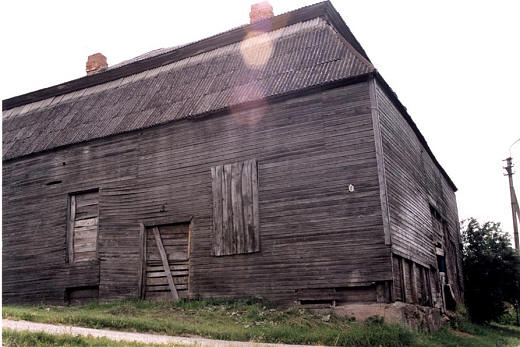
The synagogue in Pakruojis
Today, there are only eight wooden synagogues still
standing in remote villages: Pakruojis, Tirksliai, Seda, Zeizmariai,
Kurkliai, Alanta, Rozalimas and Kaltinenai. With my guide and interpreter,
Lilia Jureviciene, provided by Europos Parkas Open Air Museum of the Center
of Europe, I was able to visit five of the eight synagogues. It was an
affecting adventure. Upon arriving at a village, Lilia would ask a local
where the wooden synagogue is located. Typically, the first response would
be, "I don't know-- there is no wooden synagogue here." Eventually, someone
would recall the location of the building.
In Kurkliai, a village of 117 families, located about 100
kilometers northwest of Vilnius, we found the synagogue behind several very
old wooden cottages. Built somewhere between 1915 and 1939, it is similar in
style to eighteenth-century Romanticist/Historicist architecture. The almost
square building is one story, although the little corner tower with a small
peaked roof accommodated stairs that led up to the women's balcony. The
façade is plain with some elements of Moorish styling in the windows; that
is, they are narrow and high with a peaked triangle as a crown. It is not
known what the glass in the windows actually looked like. Today the windows
are boarded up.
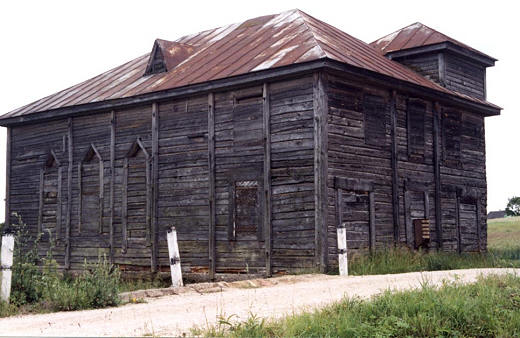
The synagogue in Kurkliai
Generally, wooden synagogues took on the appearance of
barns so as not be conspicuous. To avoid competing with the churches that
were located in the center of town, synagogues were usually erected in areas
reserved for the Jewish quarter. But there are conflicting stories about
where Jews lived. According to some people we interviewed, Jews were
scattered throughout the village and lived near their shops, wherever they
were located. Others claimed Jews lived in specific areas. In either case,
for safety, buildings were enclosed and monumental. In earlier times there
were no significant details on the façade to identify them. However in
Kurkliai, because the synagogue is of a more recent date, a Star of David
can be seen on the facade of the building. In Kurkliai the foundation is
made of bricks, although other foundations were made of stone. Each
construction is characteristic of building foundations.
Since the interiors of most of the synagogues have been
destroyed, we can only infer the layout. Based on measurements of the
building in Kurkliai, technical plans were drawn by a Mr. P. Jurenas in
1935. He concluded that the synagogue was divided into two rooms, one
slightly larger than the other. The plans indicate the staircase to the
women's balcony. In Kurkliai, as in other villages, during the Soviet
occupation the synagogue was used as a warehouse and storage building for
cars, horses, pigs and other animals. What makes the Kurkliai synagogue
remarkable is that the inside has been cleaned. Angele Dudiene, a secondary
school teacher of the natural sciences, has become the village specialist in
Jewish history. She teaches the subject in her classes. It is unclear
whether her instruction is state mandated, or she has decided to make it her
personal mission. A compassionate person with considerable initiative, she
took it upon herself to mobilize some of the townspeople and students to do
the work of clean-up. She has made the villagers aware of the building as a
religious institution. "This," she says, "is reason enough to restore it."
During the cleaning she found old newspapers and documents, including some
unspecified objects that she gave to the Vilna Gaon Jewish State Museum in
Vilnius. She has offered to have some of her teaching materials translated
from Lithuanian to English and to forward them to me when school reopens.
They are locked in her classroom for the summer.
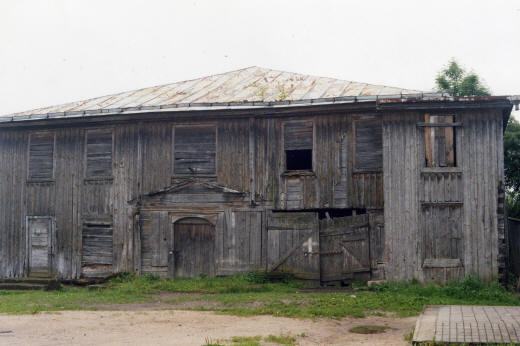
The synagogue in Zeizmariai
It is usual that one person in the village holds the key
to the synagogue, possibly the mayor. In Zeismarai, however, it is held by
an eighty-two year old Russian woman who lives near the synagogue. She was
once the caretaker of animals that were stored in the shul by the local
veterinarian during the Soviet occupation. She says, "I hold the key because
I am such a good person. Ask anyone in the village what a good person I am.
They will all tell you this is true." The synagogue in Zeismarai is quite
large, with three or four rooms on the lower floor. Although we were able to
go inside it is impossible to tell exactly how many rooms there were. The
walls and beams are collapsing, torn down or lying on the ground. Trash is
everywhere. There is a second floor but it is completely inaccessible.
Because of the size of the structure it is assumed that the Jews in the
village were prosperous.
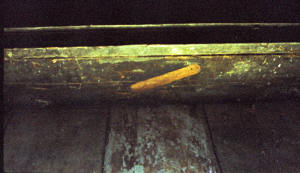 On
one of the doors one can still see a silhouette of the mezuzah (right).
According to our Russian friend, the Jews here were not ghettoized but lived
all over the town and owned a number of shops. Now, she says, "The synagogue
seems to stand more for a monument to the killing of Jews instead of a
religious institution." Last year some people from Israel, Moscow and the
USA visited Zeismarai and organized a candle-lit concert on the grounds. The
American supposedly left some money for caretaking. On
one of the doors one can still see a silhouette of the mezuzah (right).
According to our Russian friend, the Jews here were not ghettoized but lived
all over the town and owned a number of shops. Now, she says, "The synagogue
seems to stand more for a monument to the killing of Jews instead of a
religious institution." Last year some people from Israel, Moscow and the
USA visited Zeismarai and organized a candle-lit concert on the grounds. The
American supposedly left some money for caretaking.
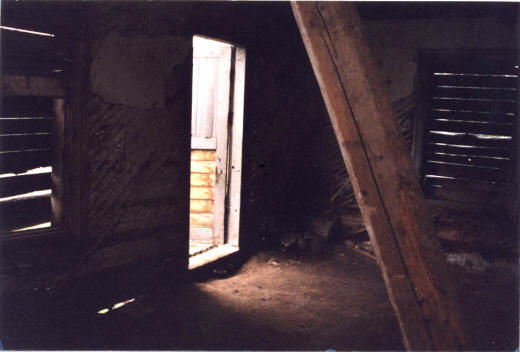
Interior of the synagogue in
Zeizmariai
Our visits to the five villages created a variety of
responses. Some people were reluctant to talk with us at first, then,
wouldn't stop, as if they needed to unburden themselves. Others literally
ran away, when we told them what we wanted. Still others just stood nearby
and listened. In Pakruojis two drunken men sitting on their porch yelled
very loudly at us in a threatening way. One woman made it very clear that
Jews never occupied the house she was living in, even though it was right
next to the synagogue and clearly in the Jewish quarter. In Rozalimas, a
woman thought it funny that she is now living in the house once occupied by
the Rabbi and laughed as she spoke about it. Nevertheless, and perhaps
surprisingly, most people we spoke to praised their Jewish neighbors. They
said "We all loved the Jews. They always helped people by giving them things
and money. We can't understand why such terrible things happened."
Because of the curious attitudes of those we encountered
and the uncertainty surrounding the question of the synagogues, I resolved
to learn the government's official position on the subject. I gained easy
access to Ms. Diana Varnaite, Director of the Department of Cultural
Heritage of Lithuania, and Mr. Alfredas Jomantas, Head of International
Cooperation, Department of Cultural Heritage Protection. According to these
high officials, the government of Lithuania is taking serious steps to raise
awareness of the rich cultural heritage left by the Jews and their important
role in Lithuania's cultural history. For the European Heritage Days, a
major event planned for September, Lithuania was appointed to choose
the team for Jewish Cultural Heritage Awareness. Seminars, lectures and
other events have been planned to educate and raise consciousness. According
to Ms Varnaite, the launching of cultural tourism, protection of monuments
and education are top priorities. She says, "It important to begin now while
the material heritage is still in the memories of the people."
But a dilemma remains. If the synagogues are restored,
what will they be restored to? What will they become? Some suggestions
include multicultural centers, museums or art schools. One village had
considered turning its old synagogue into a disco, but was short on funds.
All images © Joyce
Ellen Weinstein
[Deutsch]
Joyce Ellen Weinstein
Born
in New York, Joyce Ellen Weinstein later moved to Washington, DC. USA, She
received her Masters in Fine Arts from the City College of New York, and
attended The Art Students League. She received fellowships to Mishkenot
Sha’ananim,
Jerusalem, Israel; Blue Mountain Art Center, New York, as
resident painted a mural in Prague, Czech Republic. In 2000/2004/2005 she
was Artist in Residence at Europos Parkas, Open-Air Museum of the Center of
Europe, Vilnius, Lithuania. Her works are in permanent collections of the
National Museum of Women in the Arts, Washington, DC; Hebrew Union College
Institute of Religion Museum, NYC., Gallerie-Junge KunstWerkStart, Vienna,
Austria; The Social-Cultural Center, Prague, Czech Republic; Amnesty
International; Einchen Americe, Princeton, New Jersey, among others. Works
are in private collections in the US and Europe. She is included in “Fixing
the World: Jewish American Artists of the Twentieth Century”, by Ori Z
Soltes, New England University Press. Ms. Weinstein will be exhibiting at
the Biennale Internazionale Dell’Arte Contemporanea in Florence, Italy
December 2005.
Works of Joyce Ellen
Weinstein based on the wooden synagogues
Joyce Ellen
Weinstein's website
hagalil.com 07-06-2005 |